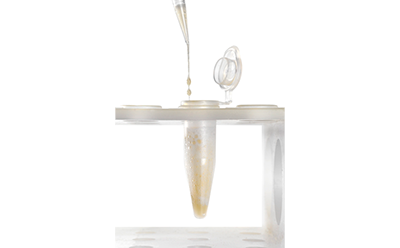Your Guide To
Protein Research

Empower Your Protein Research
Refine your protein research for optimal efficiency and reliability. Explore the potential and significance of proteins using our solutions to extract, isolate, and analyze your proteins of interest. Our diverse portfolio of solutions streamlines the entire process, preserving integrity and protecting against degradation throughout your workflow.
Our reliable methods and innovative detection tools empower you to deliver comprehensive insights into your target proteins' properties and functions.
Protein Biology Workflow


Protein Purification
After cell lysis and extraction, the next step is protein purification. Isolating proteins often uses affinity chromatography with antibodies, recombinant or fusion tags, or biotinylated tags. The type of tag and purification system depends on the protein of interest and the expression system. Our portfolio of protein purification tools includes affinity columns and resins, magnetic bead columns, agarose beads and affinity gels for antibody purification, biotinylated agarose bead and affinity gels, and more:
Antibodies
Antibodies play a crucial role in protein isolation and analysis. As versatile reagents that directly and uniquely bind to a protein or molecule of interest (primary antibodies) or another antibody (secondary antibodies), they enable various techniques to identify the presence (or absence), quantity, and location of their target. We provide highly cited and validated primary, secondary, and recombinant monoclonal antibodies, including ZooMAb® recombinant monoclonal antibodies. Our ZooMAb® recombinant antibodies are proprietary recombinant monoclonal antibodies purified to homogeneity that offer the superior specificity, high reproducibility, and a greener alternative. With our antibodies, analyses such as Western blot, immunohistochemistry, ELISA, and other assays are made easier:
Enzymes & Reagents
Protein research workflows are not complete without enzyme tools for protein research, including our collection of highly characterized and high purity proteases, nucleases, and glycosidases. These enzymes are vital for protein isolation, purification, and identification, as well as further proteomics research, including post-translational modifications (PTM) analysis, mass spectrometry (MS) analysis, and tandem MS. Our family of proteins includes:

Protein Labels & Detection
A crucial aspect of the protein research workflow, detecting and quantifying proteins involves measuring the levels of specific proteins in a sample and provides insights into protein expression, abundance, and changes under different experimental conditions. Protein labels and other detection substrates can be used for identification and other assays including enzyme assays, ELISA, imaging, blotting, protein-protein interactions, and more. We also offer a collection of reagents, buffers, and stains for protein electrophoresis and Western blotting:
Related Resources
Extract
- Lysing Enzymes
Enzymatic cell lysis and protoplast prep processes demystified, revealing complex enzymatic reactions during sample preparation.
- BugBuster® and Benzonase® Reagents are the Clear Solutions to Simple, Efficient Extraction of E. coli Proteins
This article shows the use of BugBuster® and Benzonase® as protein purification tools to extract recombinant proteins from E. coli and to reduce the viscosity of the extract.
- Quick Tips for Easy Protein Extraction Infographic
Lyse it. Protect it. Enhance it. Use it.
Protect
- Protease Inhibitor Cocktails
Protease Inhibitor Cocktails maintain and preserve cellular protein composition following cell lysis. When used with CelLytics, they also preserve target protein activity. These cocktails have been optimized for a wide variety of specific applications, ensuring excellent inhibition and ease of use.
- Phosphatase Inhibitor Cocktail
The use of phosphatase inhibitors is critical for all types of phosphorylation studies. Compare phosphatase inhibitor cocktails to select the best one for your research.
- ReadyShield Phosphatase and Protease Inhibitor Cocktail FAQ
ReadyShield® phosphatase and protease inhibitor cocktail FAQ for sample protection in a variety of cell types and tissue extracts, including mammalian, plant, and microbial samples. Our ReadyShield® Protease Inhibitor Cocktail is a non-freezing solution that contains inhibitors with a broad specificity for serine, cysteine, acid proteases and aminopeptidases.
Mass Spec
- The Importance of Filtration in Optimizing (U)HPLC and LC-MS Performance
Learn how filter selection and sample and mobile phase filtration impact HPLC back pressure and column lifetime.
Enrich
- Rapid Antibody Concentration with Amicon® Ultra Centrifugal Filters
Filtration methods and membrane filter selection in nanoparticle purification and production.
- Rapid Antibody Concentration with Amicon® Ultra Centrifugal Filters
Purification protocols for immunoglobulins generally include affinity binding to Protein A or G chromatography media, washing unbound proteins, and eluting with a low pH buffer.
- Virus Concentration by Ultrafiltration
Ultrafiltration using Amicon® Ultra centrifugal devices for concentrating virus in preparation of high titer virus stocks and isolation of virus from samples.
- Large Volume Concentration and Diafiltration with Amicon® Stirred Cells
Demonstrating the effective use of Amicon® Stirred Cell for large volume concentration through diafiltration.
Purify
- Protein Tags At-A-Glance Infographic
Protein tags allow detection and purification without needing an antibody specific to your protein of interest.
- Anti-FLAG® M2 Magnetic Beads
Comparison of elution techniques for small-scale protein purification of FLAG® tag proteins using anti-FLAG® M2 magnetic beads.
- Lectin Selection Guide: A Useful Guide for Selecting the Right Lectin
Find the right lectin for your research with our lectin selection guide, organized by lectin source/species, carbohydrate specificity, blood group specificity, and more.
Modify
- O-Linked Glycan Strategies
Learn about O-linked glycan strategies, O-glycosidase actions, how to remove sialic acid residues, β-Elimination, and O-glycan modifications.
- Strategies for Deglycosylating N-Linked Glycans
Explore strategies for releasing N-linked glycans with PNGase F, PNGase A & native & sequential deglycosylation with endoglycosidases & exoglycosidases.
- Improving Glycoform Coverage for Mucin Preparations
Pretreatment with Mucinase StcE increases glycopeptide identification from mucin samples, enhancing sample preparation efficiency for glycopeptide analysis.
Function & Structure
- Duolink® PLA Applications
Applications to detect, quantify and visualize protein-protein interactions, post-translational modifications and low expression protein detection using proximity ligation assay.
- Antibody Enhanced-Validation Strategies
Antibody enhanced validation provides additional data to help ensure antibody specificity and performance and to address antibody reproducibility crisis.
- Studying Hallmarks of Cancer With Recombinant Antibodies
Learn about the hallmarks of cancer and find reliable ZooMAb® recombinant antibodies to study them, conveniently organized by cancer hallmark.
- ZooMAb® Recombinant Antibody Technology
Learn how ZooMAb® antibodies are engineered for consistency using our proprietary recombinant expression system.
PTMs & Mass Spec
- Lectin Selection Guide: A Useful Guide for Selecting the Right Lectin
Find the right lectin for your research with our lectin selection guide, organized by lectin source/species, carbohydrate specificity, blood group specificity, and more.
- Mass Spectrometry of Glycans
Explore mass spectrometry analysis of glycans for glycomic & glycoproteomic neutral & acidic glycan analysis. See a general mass spec glycan analysis procedure.
- HPLC Analysis of Glycans
Uncover how HPLC analysis of glycans helps researchers analyze glycan structures and glycoforms & find products to assist in your glycan analysis methods.
- Complete LC-MS Analysis for Consistent Results
Learn about columns, solvents, buffers, reagents and accessories that are designed for your LC-MS applications from Supelco®.
Quantify
- Auto2D® Gel Electrophoresis Device
Auto2D® automates difficult 2D electrophoresis methods for protein localization with high reproducibility in under two hours.
- Bis Tris Polyacrylamide Gel Electrophoresis Technology
Bis-Tris SDS-PAGE gel casting kits with mPAGE® TurboMix technology for rapid, reliable gel casting and protein separation.
- mPAGE®Lux Casting System for SDS-PAGE Gels
Refresh your gel casting workflow with ready-to-use SDS-PAGE gels in just 3 minutes. Discover faster, simpler, and safer gel casting methods.
- Handbook: Protein Blotting Tips and Tricks
This handbook represents the collective experience of our application scientists, who are actively engaged in advancing the science of protein blotting and detection.
- 30-minute Immunodetection Protocol Using the SNAP i.d.® 2.0 System
The SNAP i.d.® 2.0 Protein Detection System is the second generation of the SNAP i.d.® method for detecting immunoreactive proteins on Western blots.
- Conferma® ELISAs: Designed for Sample Detection & Lot Consistency
Learn about the Conferma® ELISA development and manufacturing methods that provide strong sample detection and long-term assay and lot consistency, giving you confidence in your research.
- Overview of Luminex® Multiplex Assay Technology | MILLIPLEX® Multiplex Assays
Discover the benefits of MILLIPLEX® multiplex assays, based on Luminex® xMAP® multiplex assay technology, that provide consistent, high-quality results and see how these multiplex biomarker Luminex® assays are being used to advance research.
- How to Select Your Immunoassay Platform
Explore how to select the best immunoassay platform for your research by choosing between multiplex and singleplex biomarker detection assays, immunoassay instrument platforms, immunoassay software, and services.
- Overview of Ultrasensitive Immunoassay Technology | SMC® Technology
Explore ultrasensitive immunoassay technology with SMC® technology, including its biomarker detection platform, advantages of high sensitivity assays, and more.
To continue reading please sign in or create an account.
Don't Have An Account?